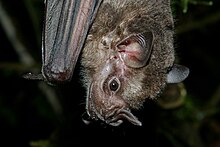Jamaica fruit bat
| Jamaica fruit bat | ||||||||||||
|---|---|---|---|---|---|---|---|---|---|---|---|---|

Jamaican fruit bat ( Artibeus jamaicensis ) |
||||||||||||
| Systematics | ||||||||||||
|
||||||||||||
| Scientific name | ||||||||||||
| Artibeus jamaicensis | ||||||||||||
| ( Leach , 1821) |
The Jamaican fruit bat ( Artibeus jamaicensis ) is a bat species from the leaf-nosed family (Phyllostomidae), which is native to Central and South America.
description
The Jamaican fruit bat is a medium-sized bat weighing 50–60 g. The color of the coat varies from dark brown to ash gray and is usually lighter in the abdomen than on the back. Like most representatives of the leaf noses , the Jamaican fruit bat also has a pronounced nasal leaf . The name Artibeus is derived from the Greek arti (= face stripe ) and beus (refers to the presence of the stripes). However, the facial stripes are not always present in the Jamaican fruit bat, or only slightly.
Way of life
The Jamaican fruit bat is one of the most common and widespread species of the Artibeus genus . It is found in many tropical habitats such as rainforest , cloud forest, and seasonal dry forest , and is also found near human settlements and on farmland. In addition to tree hollows, Jamaican fruit bats use modified leaves of various plants to sleep. Where a leaf is gnawed so that it collapses and thus forms a "tent" depends heavily on the type of plant. Jamaica fruit bats have a polygynous mating system in which a male either defends a territory or several females (harem) against other males. The latter is especially the case when resources such as the hanging place are not limited. Colonies in tree hollows can consist of multiple harems with an average of six sexually mature females and groups of bachelor males and not yet reproductive females. Well-known predators of the Jamaican fruit bat are the barn owl and the idol snake . Other possible enemies are other species of snakes and owls, coatis , larger possums and the bat falcon ( Falco rufigularis ). If a bat is caught by a predator, it produces loud alarm calls that can also be heard by humans. Jamaica fruit bats can live up to nine years.
nutrition
The Jamaican fruit bat specializes in figs . Jamaica fruit bats can go foraging alone or in groups and visit the same tree several times. Your digestive system processes the food within 30 minutes, during which only about 30% of the potential energy of the fruit can be absorbed. Since the digestive tract of the Jamaican fruit bat only absorbs the juice of the figs, it is possible for them to consume large quantities of figs without unnecessarily losing energy through the food in the stomach when flying. A single Jamaican fruit bat consumes about twice its body weight in one night. When foraging for food, Jamaican fruit bats rely on their excellent sense of smell and sight. Although the fruits make up up to 40% of the bat's body weight, found fruits are often carried several hundred meters to a feeding place. This makes the Jamaican fruit bat an efficient and therefore important seed spreader .
Reproduction
Females of the Jamaican fruit bat are polyestrial and give birth to one or rarely two young twice a year. The young are born after a gestation period of 3.5–4 months during the dry season. During the second annual gestation period, a delayed embryonic development of up to 7 months is possible in females, which is why the young can be born in the next breeding season. It is believed that the exact time of birth depends on the availability of fruit. During the first days after birth, the young animals are carried around by the mother, but then later remain in the hanging place. The young are suckled for an average of 15 days and begin to fly from the age of 50 days. Sexual maturity begins at 8 months for females and 12 months for males.
distribution and habitat
The distribution of the Jamaican fruit bat ranges from Mexico to Ecuador to Peru . Their populations are classified as stable and safe by the IUCN thanks to their widespread distribution and relative tolerance to man-made disturbance.
literature
- J. Ortega, I. Castro-Arellano: Artibeus jamaicensis , Mammalian Species , No. 662 (2001): pp. 1-9
Web links
swell
- ^ TH Kunz & GF McCracken 1995: Tents and harems: apparent defense of foliage roost by tent-making bats. Journal of Tropical Ecology 11. pp. 1-17
- ^ Morrison, DW 1980: Efficiency of food utilization by fruit bats. Oecologia 45. pp. 270-273
- ↑ Heithaus, ER, Fleming, TH, Opler, PA 1975: Foraging patterns and resource utilization in seven species of bats in a seasonal tropical forest. Ecology 56. pp. 841-854
- ↑ Artibeus jamaicensis in the IUCN Red List of Threatened Species

